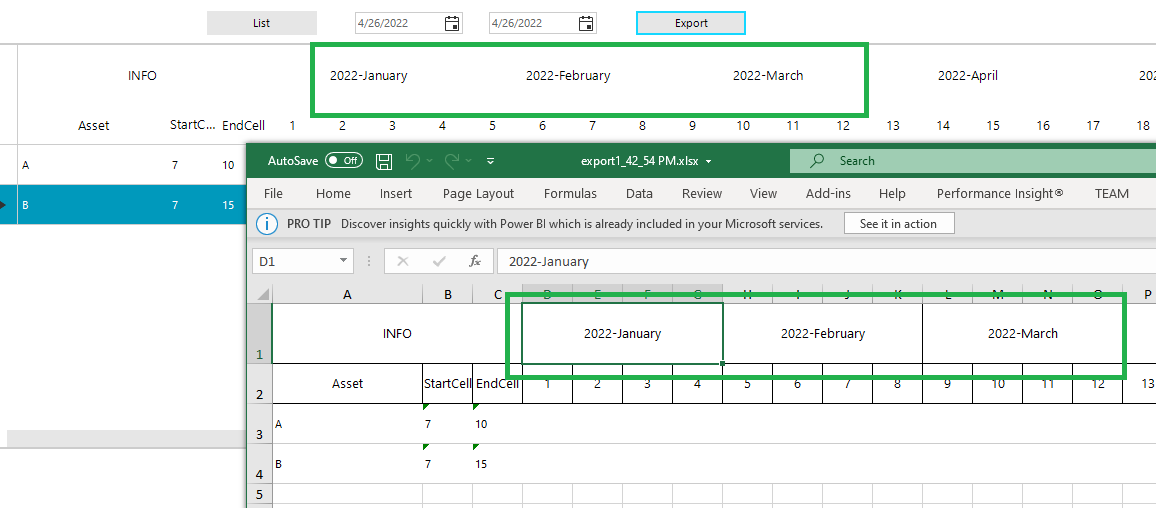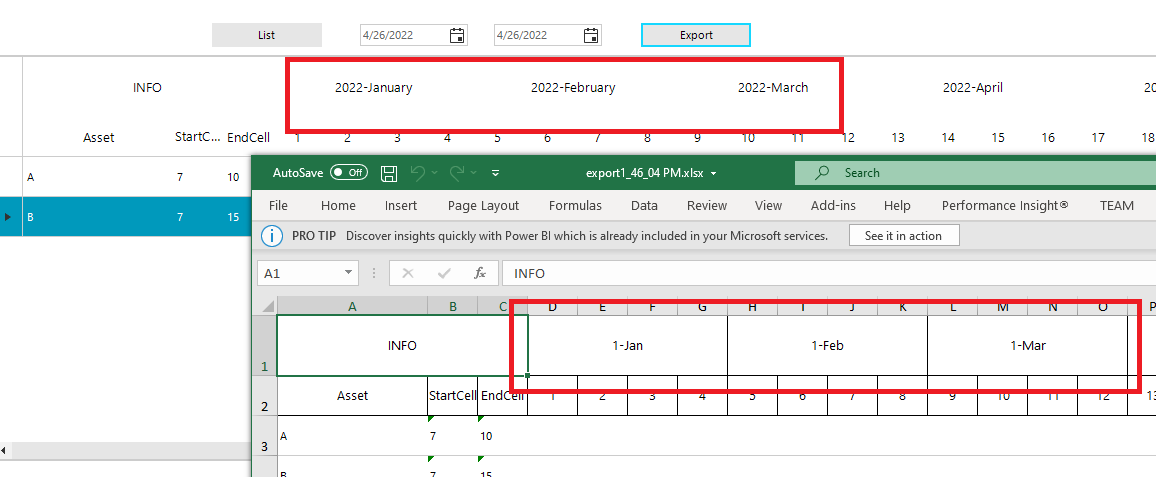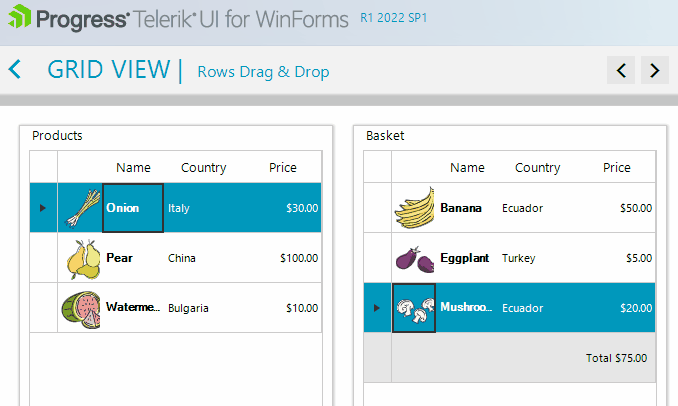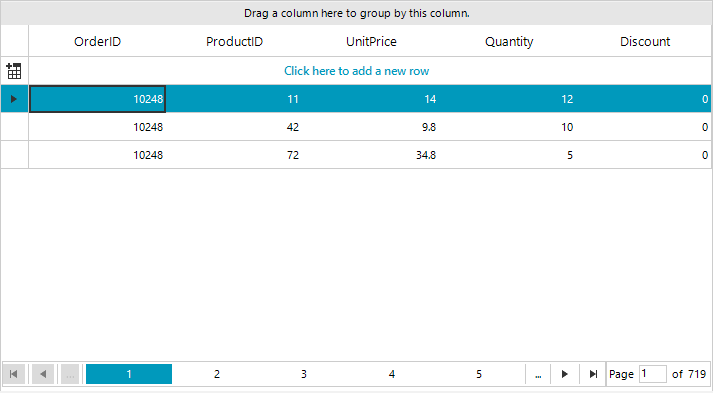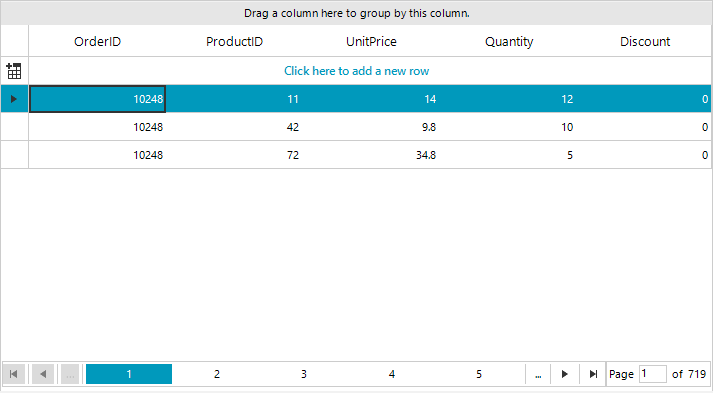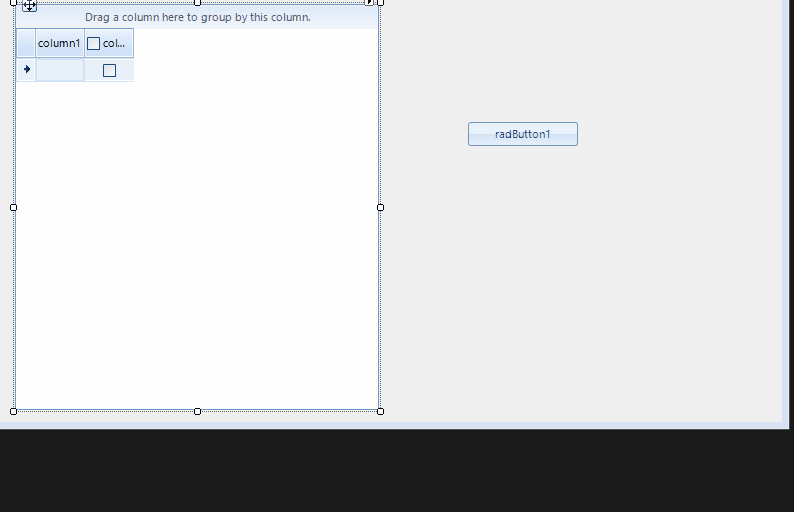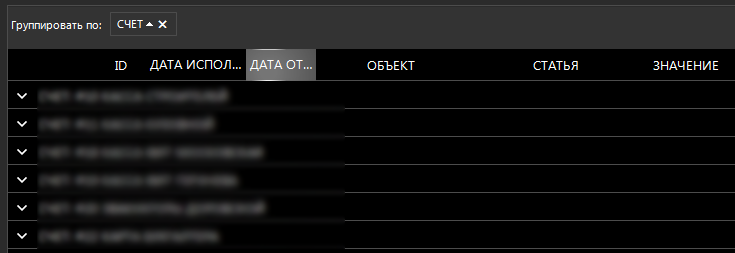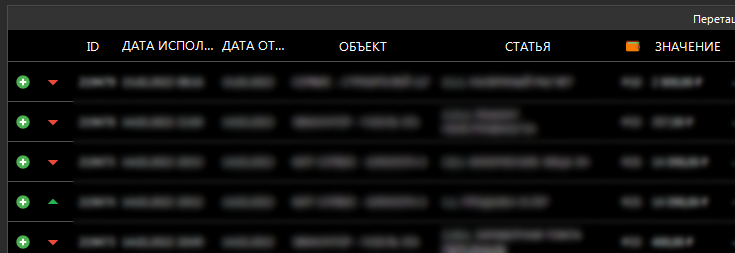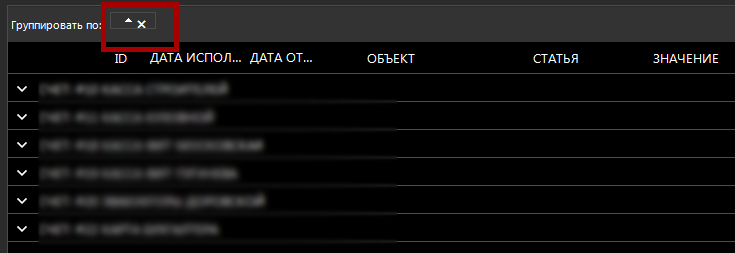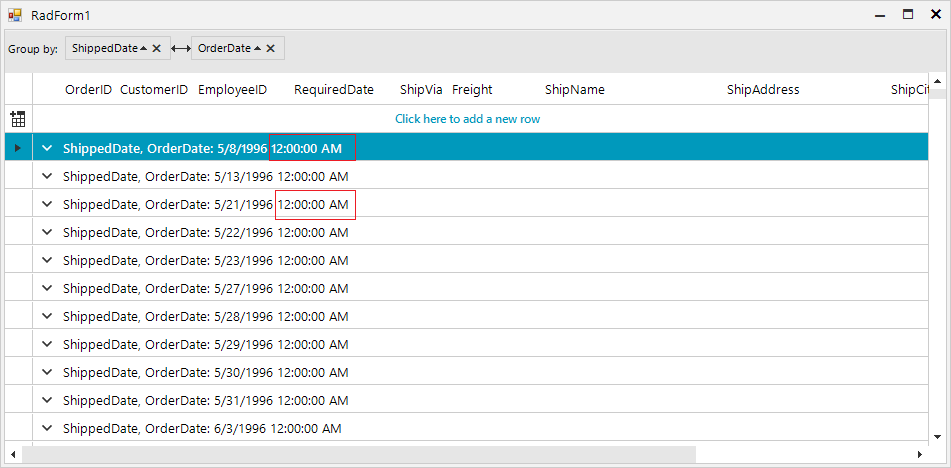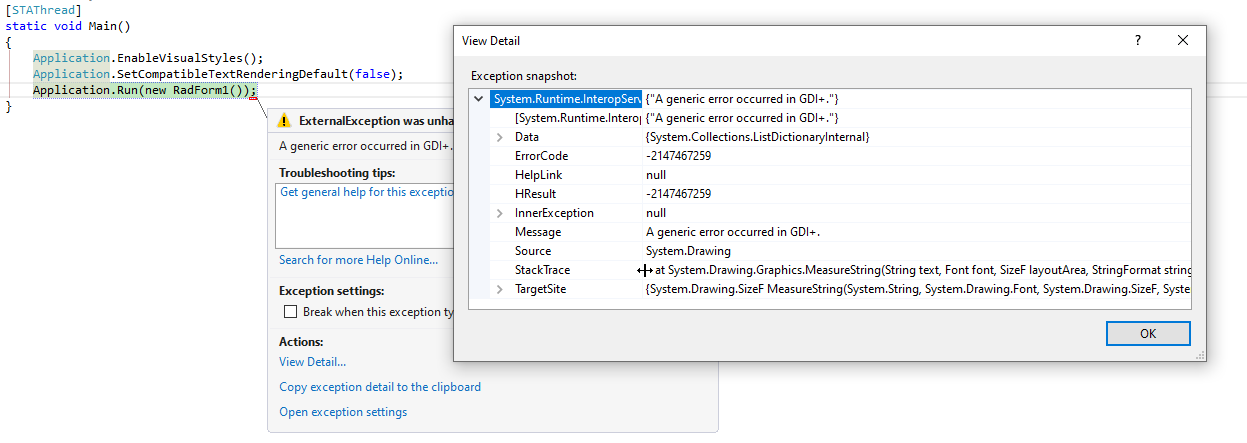Hi
I just found a strange issue using the latest bits of the Telerik RadGridView.
I have a grid that contains ColumnGroupsViewDefinition. Inside one of the group, one of the column is a GridViewComboBoxColumn.
The grid shows correctly on the screen.
If I try to export it using GridViewSpreadExport, I get an exception saying "input string was not in a correct format".
The export works fine if:
-I don't have groups
-I export to HTML using ExportToHTML
-I export to HTML using ExportToCSV
Any help please?
Run the attached project and click List then Export.
Expected:
Actual:
Workaround:
Private Sub RadButton2_Click(sender As Object, e As EventArgs) Handles RadButton2.Click
Dim spreadExporter As GridViewSpreadExport = New GridViewSpreadExport(gvAssetSchedule)
AddHandler spreadExporter.CellFormatting, AddressOf spreadExporter_CellFormatting
Dim exportRenderer As New SpreadExportRenderer()
spreadExporter.ExportVisualSettings = True
Dim filename = "..\..\export" & DateTime.Now.ToLongTimeString().Replace(":", "_") & ".xlsx"
spreadExporter.RunExport(filename, exportRenderer)
Process.Start(filename)
End Sub
Private Sub spreadExporter_CellFormatting(sender As Object, e As Telerik.WinControls.Export.CellFormattingEventArgs)
If e.GridCellInfo Is Nothing Then
Dim selection As CellSelection = e.CellSelection
Dim range As CellRange = selection.CellRanges(0)
Dim val = selection.Worksheet.Cells(range.FromIndex.RowIndex, range.FromIndex.ColumnIndex).GetValue()
Dim format As New CellValueFormat("@")
selection.Worksheet.Cells(range.FromIndex.RowIndex, range.FromIndex.ColumnIndex).SetFormat(format)
Dim dt As New DateTime(1900, 1, 1)
Dim parsedDays = 0
If Integer.TryParse(val.Value.RawValue, parsedDays) Then
dt = dt.AddDays(parsedDays)
selection.Worksheet.Cells(range.FromIndex.RowIndex, range.FromIndex.ColumnIndex).SetValue(dt.Year & "-" & MonthName(dt.Month))
End If
End If
End Sub
Please refer to the below gif file. You will notice that the drop row line is shown only when dropping in the same grip but not when dropping on another grid:
Workaround: use the project in the following forum post: https://www.telerik.com/forums/preview-drop---drag-drop-between-gridview#5477699
Steps to reproduce:
1.Run the attached sample project.
2.Group by the ProductID column
3.Select Page 4
4. Expand the top group row. You will notice that the grid jumps to a previous row.
Expected:
Actual:
Workaround:
public class CustomGrid : RadGridView
{
public override string ThemeClassName
{
get
{
return typeof(RadGridView).FullName;
}
}
protected override void OnMouseDown(MouseEventArgs e)
{
GridExpanderItem expander = this.ElementTree.GetElementAtPoint(e.Location) as GridExpanderItem;
if (expander != null)
{
flag = true;
}
base.OnMouseDown(e);
}
protected override void OnMouseUp(MouseEventArgs e)
{
base.OnMouseUp(e);
flag = false;
}
bool flag = false;
protected override void OnPageChanging(object sender, PageChangingEventArgs e)
{
if (flag)
{
e.Cancel = true;
}
base.OnPageChanging(sender, e);
}
}
ComboBox column DataSource property is not visible in the Designer MS Property Builder when the previously selected node was RadGridView.
Eery time I use the GridView, I have to remember to un-select the last item in the list.
This is almost always to wrong thing to be selected - so why select it by default?
..and the way to swith this 'feaure' off isn't obvious - I always have to look it up....RadGridView1.CurrentRow = Nothing
When the RadGridView AutoSize property is set to true and a row is expanded, an exception is thrown:
System.InvalidOperationException: 'MeasureOverride returned positive infinity: Telerik.WinControls.UI.GridDetailViewRowElement'
A possible workaround is to replace the GridDetailViewRowElement with your own class. Then overriding the MeasureOverride method we can pass valid size to the element.
private void RadGridView1_CreateRow(object sender, GridViewCreateRowEventArgs e)
{
if (e.RowInfo is GridViewDetailsRowInfo)
{
e.RowElement = new MyGridDetailViewRowElement();
}
}
public class MyGridDetailViewRowElement : GridDetailViewRowElement
{
protected override SizeF MeasureOverride(SizeF availableSize)
{
var baseSize = base.MeasureOverride(availableSize);
if(baseSize.Width == float.PositiveInfinity)
{
baseSize.Width = 800;
}
return baseSize;
}
}
To reproduce: please run the attached sample project and follow the steps illustrated in the attached gif file:
Scrolling to a newly added row does not work when inner templates are visible.
Add data to the inner templates of several rows near the bottom using the button.
Expand these inner templates so they are all visible.
Scroll back up to the top.
Add a new item to the outer grid normally.
The table will jump to where it things the new item is but will fall short, instead scrolling to a location in one of the inner templates.
Workaround:
private void RadGridView1_UserAddedRow(object sender, GridViewRowEventArgs e)
{
foreach (GridViewRowInfo row in this.radGridView1.Rows)
{
if (row.IsExpanded)
{
row.IsExpanded = false;
row.IsExpanded = true;
}
}
}
Hi. it was great to see the option "ImageOnly", for columns of small width, where only the image is placed in the header, and the "HederText" property was set, for the correct display of the grouping field
GridViewDataColumn column;
column.HeaderText = "Счет";
column.HeaderImage = ...; // some img
column.TextImageRelation = TextImageRelation.Overlay;GridViewDataColumn column;
column.HeaderText = "";
column.HeaderImage = ...; // some img
column.TextImageRelation = TextImageRelation.Overlay;it’s impossible to choose one thing, either an ugly header, or a grouping without a description
Use the following code snippet:
GridViewDateTimeColumn orderDate = this.radGridView1.Columns["OrderDate"] as GridViewDateTimeColumn;
orderDate.Format = DateTimePickerFormat.Custom;
orderDate.CustomFormat = "dd-MM-yyyy";
orderDate.FormatString = "{0:dd-MM-yyyy}";
GridViewDateTimeColumn shippedDate = this.radGridView1.Columns["ShippedDate"] as GridViewDateTimeColumn;
shippedDate.Format = DateTimePickerFormat.Custom;
shippedDate.CustomFormat = "dd-MM-yyyy";
shippedDate.FormatString = "{0:dd-MM-yyyy}";When the grid is grouped by a column with a specific format, it should be taken in consideration by the group row as well.
Call the EndPrint method after the printing.
this.radGridView1.Print(true, this.radPrintDocument1);
(this.radGridView1 as IPrintable).EndPrint(null, null);
Please run the sample project and follow the steps:
1.Open the attached solution in Visual Studio - I am using VS 2022.2.Select the Grid.
3.Edit the templates.
4.For gridViewTemplate1, set SelectNewRowasCurrent to false.
5.Close the editor.
6.Close the WinForms designer.
7.Open the WinForms designer again.
Use this XML layout:
this.radGridView1.LoadLayout(@"..\..\..\Layout.xml");
<RadGridView Padding="0, 0, 0, 1" Cursor="Default" TabIndex="49">
<MasterTemplate EnableGrouping = "True" AllowEditRow="False" AllowDeleteRow="False" AllowAddNewRow="False" EnableFiltering="True" AutoExpandGroups="True">
<Columns>
<Telerik.WinControls.UI.GridViewTextBoxColumn Width="100" FieldName="JobID" Name="JobID" IsAutoGenerated="True" IsVisible="True" HeaderText="JobID" />
<Telerik.WinControls.UI.GridViewTextBoxColumn Width="100" FieldName="CustomerID" Name="CustomerID" IsAutoGenerated="True" IsVisible="True" HeaderText="CustomerID" />
<Telerik.WinControls.UI.GridViewTextBoxColumn Width="285" FieldName="StatusID" Name="StatusID" IsAutoGenerated="True" IsVisible="True" HeaderText="StatusID" />
<Telerik.WinControls.UI.GridViewTextBoxColumn Width="100" FieldName="UnitID" Name="UnitID" IsAutoGenerated="True" IsVisible="True" HeaderText="UnitID" />
<Telerik.WinControls.UI.GridViewTextBoxColumn Width="100" FieldName="OperatorID" Name="OperatorID" IsAutoGenerated="True" IsVisible="True" HeaderText="OperatorID" />
<Telerik.WinControls.UI.GridViewTextBoxColumn Width="100" FieldName="JobTypeID" Name="JobTypeID" IsAutoGenerated="True" IsVisible="True" HeaderText="JobTypeID" />
<Telerik.WinControls.UI.GridViewTextBoxColumn Width="100" FieldName="JobCatID" Name="JobCatID" IsAutoGenerated="True" IsVisible="True" HeaderText="JobCatID" />
<Telerik.WinControls.UI.GridViewDateTimeColumn Width="100" FieldName="StartTime" Name="StartTime" IsAutoGenerated="True" IsVisible="True" HeaderText="StartTime">
<FilterDescriptor xsi:type="Telerik.WinControls.Data.DateFilterDescriptor" Value="" IgnoreTimePart="False" PropertyName="StartTime" Operator="IsNotNull" IsFilterEditor="True" xmlns:xsi="http://www.w3.org/2001/XMLSchema-instance" />
</Telerik.WinControls.UI.GridViewDateTimeColumn>
<Telerik.WinControls.UI.GridViewDateTimeColumn Width="100" FieldName="FinishTime" Name="FinishTime" IsAutoGenerated="True" IsVisible="True" HeaderText="FinishTime" />
<Telerik.WinControls.UI.GridViewDateTimeColumn Width="100" FieldName="CreateDate" Name="CreateDate" SortOrder="Descending" IsAutoGenerated="True" IsVisible="True" HeaderText="CreateDate" />
<Telerik.WinControls.UI.GridViewDateTimeColumn Width="100" FieldName="StatusJobDate" Name="StatusJobDate" IsAutoGenerated="True" IsVisible="True" HeaderText="StatusJobDate" />
<Telerik.WinControls.UI.GridViewTextBoxColumn Width="100" FieldName="UserID" Name="UserID" IsAutoGenerated="True" IsVisible="True" HeaderText="UserID" />
<Telerik.WinControls.UI.GridViewTextBoxColumn DataType="System.Guid" Width="100" FieldName="TableKey" Name="TableKey" IsAutoGenerated="True" IsVisible="False" HeaderText="TableKey" />
</Columns>
<FilterDescriptors>
<Telerik.WinControls.Data.DateFilterDescriptor Value="" IgnoreTimePart="False" PropertyName="StartTime" Operator="IsNotNull" IsFilterEditor="True" />
</FilterDescriptors>
<SortDescriptors>
<Telerik.WinControls.Data.SortDescriptor PropertyName="CreateDate" Direction="Descending" />
</SortDescriptors>
<ViewDefinition xsi:type="Telerik.WinControls.UI.TableViewDefinition" xmlns:xsi="http://www.w3.org/2001/XMLSchema-instance" />
</MasterTemplate>
</RadGridView>Workaround:
public class CustomGridView : RadGridView
{
protected override GridViewLayoutSerializer CreateGridViewLayoutSerializer(Telerik.WinControls.XmlSerialization.ComponentXmlSerializationInfo info)
{
return new CustomGridViewLayoutSerializer(info);
}
public override string ThemeClassName
{
get
{
return typeof(RadGridView).FullName;
}
}
}
public class CustomGridViewLayoutSerializer : GridViewLayoutSerializer
{
public CustomGridViewLayoutSerializer(ComponentXmlSerializationInfo componentSerializationInfo) : base(componentSerializationInfo)
{
}
protected override bool ProcessReaderAttribute(System.Xml.XmlReader reader, object parentObject, object toRead, PropertyDescriptor property)
{
if (toRead is FilterDescriptor && reader.Value == string.Empty)
{
object val = reader.Value;
if (property.ComponentType == typeof(DateFilterDescriptor))
{
val = null;
}
this.SetPropertyValue(property, toRead, val);
return true;
}
return base.ProcessReaderAttribute(reader, parentObject, toRead, property);
}
}
Please refer to the sample project and open the Home form. The attached gif file illustrates how to reproduce the error.
Workaround: define the grid relations via code.
To reproduce:
public RadForm1()
{
InitializeComponent();
string txt = "what follows is test characters (some of) which should cause error: เปลี่ยน UPS ที่ห้อง Truck scale เนื่องจากเมื่อวันพฤหัสที่ 13 มีการออฟเบรกเกอร์ที่ ฺฺB/H แต่ว่า เครื่องคอมพิวเตอร์ที่ T/S ดับ ตัว UPS ไม่ทำงาน ทำให้ข้อมูลขณะนั้นหายไป ";
this.label1.Text = txt; // No error
Font font = this.label1.Font;// new Font("Segoe UI", 9.5f, FontStyle.Regular);
this.radLabel1.Font = font;
this.radLabel1.Text = txt; //GDI error
}Workaround:
this.radLabel1.UseCompatibleTextRendering = false;
To reproduce :
public partial class RadForm1 : Telerik.WinControls.UI.RadForm
{
public RadForm1()
{
InitializeComponent();
radGridView1.DataSource = GetTable();
}
private void radButton1_Click(object sender, EventArgs e)
{
var exporter = new GridViewPdfExport(radGridView1);
exporter.FileExtension = "pdf";
exporter.ShowHeaderAndFooter = true;
exporter.LeftFooter = GridViewPdfExport.DatePrintedString;
exporter.FitToPageWidth = true;
exporter.PageMargins = new Padding(20, 15, 10, 10);
exporter.RunExport(@"C:\Users\dkaramfi\Desktop\test123.pdf", new PdfExportRenderer());
}
static DataTable GetTable()
{
DataTable table = new DataTable();
table.Columns.Add("Dosage", typeof(int));
table.Columns.Add("Drug", typeof(string));
table.Columns.Add("Name", typeof(string));
table.Columns.Add("Name1", typeof(string));
table.Columns.Add("Name2", typeof(string));
table.Columns.Add("Name3", typeof(string));
table.Columns.Add("Name4", typeof(string));
table.Rows.Add(50, "Enebrel", "Sam", "Sam1", "Sam2", "Sam4", "Sam4");
table.Rows.Add(25, "Indocin", "David");
table.Rows.Add(50, "Enebrel", "Sam");
table.Rows.Add(10, "Hydralazine", "Christoff");
table.Rows.Add(21, "Combivent", "Janet");
table.Rows.Add(100, "Dilantin", "Melanie");
return table;
}
}
Workaround:
Leave the default margins.

